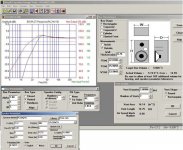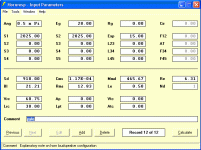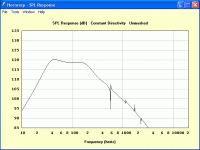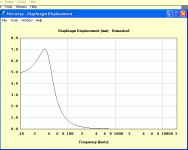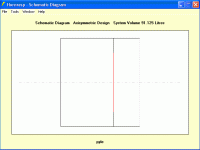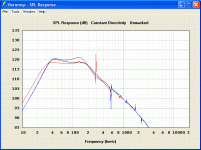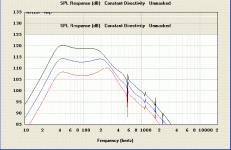One more vote for 5 ft^3.
Hi djk,
You may have noticed by now that the Tang Band is not 100W into 8 Ohms, and that you modelled it in a corner. Without some good solid corners the spl would be lower. So, maybe the comparison is not quite as bad. Obviously, jbells single sheet TH with the Eminence 3015LF would be much better.
Hi pikipupiba,
Here is another simulation for a 5 ft^3 vented enclosure, this one is done in Boxplot. Please, notice that I'm adding a 42Hz, 1st order low cut filter to cut down on the low end bump and to prevent excessive low end excursion, the -10dB point is @20Hz. 5 ft^3 is also just fine for a sealed enclosure, for -10dB @ 20Hz you now need a 27Hz 1st order low cut filter, and the response looks smoother.
This size box would also be a good thing to have around to measure T/S parameters. As long as we don't have the parameters for the speaker you have, we are all just guessing.
Regards,
Hi djk,
You may have noticed by now that the Tang Band is not 100W into 8 Ohms, and that you modelled it in a corner. Without some good solid corners the spl would be lower. So, maybe the comparison is not quite as bad. Obviously, jbells single sheet TH with the Eminence 3015LF would be much better.
Hi pikipupiba,
Here is another simulation for a 5 ft^3 vented enclosure, this one is done in Boxplot. Please, notice that I'm adding a 42Hz, 1st order low cut filter to cut down on the low end bump and to prevent excessive low end excursion, the -10dB point is @20Hz. 5 ft^3 is also just fine for a sealed enclosure, for -10dB @ 20Hz you now need a 27Hz 1st order low cut filter, and the response looks smoother.
This size box would also be a good thing to have around to measure T/S parameters. As long as we don't have the parameters for the speaker you have, we are all just guessing.
Regards,
Attachments
Playing with software is fun! 
Here's a nice, small, simple box for the Pyle driver.
width = height = 1.5 ft
depth of closed space behind driver = 1 ft
depth of open space in front of driver = 6 inches
Turning driver back-to-front so magnet faces out will give better ventilation, higher power handling.
edit: I kinda guessed some of the parameters - hopefully close enough.
Here's a nice, small, simple box for the Pyle driver.
width = height = 1.5 ft
depth of closed space behind driver = 1 ft
depth of open space in front of driver = 6 inches
Turning driver back-to-front so magnet faces out will give better ventilation, higher power handling.
edit: I kinda guessed some of the parameters - hopefully close enough.
Attachments
Last edited:
Playing with software is fun!
Here's a nice, small, simple box for the Pyle driver.
width = height = 1.5 ft
depth of closed space behind driver = 1 ft
depth of open space in front of driver = 6 inches
Turning driver back-to-front so magnet faces out will give better ventilation, higher power handling.
edit: I kinda guessed some of the parameters - hopefully close enough.
Are these measurements with the driver facing in or out? I like the idea of the driver magnet facing out for better cooling.
The software pretends the driver's flat so it doesn't matter.Are these measurements with the driver facing in or out? I like the idea of the driver magnet facing out for better cooling.
In theory, the important thing is the volume of air inside the box, so if the driver's the normal way around you should allow for the volume taken up by the magnet etc inside the box, whereas if the driver's back-to-front, there's a bit of extra volume due to the outward curvature if the cone.
Exact size doesn't seem to be critical with this design, though.
In the first pic below:
Black line is the original,
Red line is with the enclosed volume increased from 1 ft deep to 2 ft deep,
Blue line is with the open part increased from 6 to 10 inches deep.
So, with more closed space, it goes a bit deeper but with less sensitivity. Greater length of open space gives more of a peak at the top end, but at a slightly lower frequency.
btw, all of these are with 100 watts input and the speaker in a corner, so results are comparable with what djk posted earlier.
Pulling the speaker out from the corner gives more of an upward slope in the response. In the second pic below:
Black = in corner (1/8 space)
Blue = on floor, against a wall (1/4 space)
Red = on floor, away from walls (1/2 space)
There's a couple of things the software simulator doesn't tell you about though:
Firstly - the smaller the box, the greater the pressure variations inside it, which can cause a problem if the cone starts buckling or the surround bends badly or flips inside out due to the pressure.
Secondly - Some drivers might produce audible nasties if mounted back-to-front due to "chuffing" noises from the vent in the pole-piece. I still think it's worth trying the back-to-front mounting. If there's a problem, you can always just flip it around.
~~~~~~~~~~~~~~~~~~~~~~~~~~~~
A reflex box like what Oliver suggested would be a good option too, and might allow higher spl at the bottom end due to reduced cone excursion. Subsonic filtering would be more important, though.
Cheers - Godfrey
Attachments
"You may have noticed by now that the Tang Band is not 100W into 8 Ohms, and that you modelled it in a corner."
True, but I figured in a dorm room/bedroom situation one could find at least one suitable corner. As the graph shows, 28.3V into the 4R TB driver is 107W in the bass, closer to 8R than 4R.
"Obviously, jbells single sheet TH with the Eminence 3015LF would be much better."
The little 6" TB was meant to be a joke of sorts, although it can do over 120dB when used in a corner.
"As long as we don't have the parameters for the speaker you have, we are all just guessing."
For Hornresp you can just copy the input page. For T/S, just look up the model of the TB driver (on the Hornresp input page) at Parts Express.
For serious dance music I would do something like jbell's single sheet design. The 3015LF is quite inexpensive. If one had the money the BMS 15N840 looks like it would have about 6dB more output in the 40hz region, at about twice the price.
True, but I figured in a dorm room/bedroom situation one could find at least one suitable corner. As the graph shows, 28.3V into the 4R TB driver is 107W in the bass, closer to 8R than 4R.
"Obviously, jbells single sheet TH with the Eminence 3015LF would be much better."
The little 6" TB was meant to be a joke of sorts, although it can do over 120dB when used in a corner.
"As long as we don't have the parameters for the speaker you have, we are all just guessing."
For Hornresp you can just copy the input page. For T/S, just look up the model of the TB driver (on the Hornresp input page) at Parts Express.
For serious dance music I would do something like jbell's single sheet design. The 3015LF is quite inexpensive. If one had the money the BMS 15N840 looks like it would have about 6dB more output in the 40hz region, at about twice the price.
Hi djk,
I figured you were half kidding with the TB comparison. Volvotreter seems to really like the little THs has build with it.
With the speaker parameters I was referring to the PLCHW15. They are still in question.
Thanks for mentioning the BMS 15N840, when I plug its parameters into a TH simulation I had in Hornresp it is almost identical to the B&C 15TBX100. The 15N850V2 seems to be quite similar with an additional 2mm of Xmax. Another one - that according to US Speaker has just come out - is the RCF LF15G401, its Xmax is rated @ 8.5mm, but they claim a peak-to-peak excursion of 52mm.
So many speakers, so little time (and/or money) .
.
Regards,
I figured you were half kidding with the TB comparison. Volvotreter seems to really like the little THs has build with it.
With the speaker parameters I was referring to the PLCHW15. They are still in question.
Thanks for mentioning the BMS 15N840, when I plug its parameters into a TH simulation I had in Hornresp it is almost identical to the B&C 15TBX100. The 15N850V2 seems to be quite similar with an additional 2mm of Xmax. Another one - that according to US Speaker has just come out - is the RCF LF15G401, its Xmax is rated @ 8.5mm, but they claim a peak-to-peak excursion of 52mm.
So many speakers, so little time (and/or money)
Regards,
I am using a PYLE PLCHW15 driver and 3/4 inch MDF.
With 3/4" MDF you'll have to move it with a forklift... Properly braced 1/2" birch ply will drop the weight considerably.
ok, so I built the box, it's strong, sealed tight, and looks good. Verdict? The sub sucks. It sounds like crap, the magnet structure vibrates (even after tightening it), and it doesn't even get AS LOUD AS a tiny 12 I just built. EPIC FAIL!!!! I will upload pictures when I can.
I am going to save up for a nice 15" that can use a 4.5 cubic foot box, any ideas on that? I would like to keep it under $200...
I am going to save up for a nice 15" that can use a 4.5 cubic foot box, any ideas on that? I would like to keep it under $200...
if you want more output you'll need a ported/horn design.
look at pretty much every pa subwoofer and they'll be a ported or folded horn design
Search partsexpress.com for 15" LF drivers under the Pro Audio tab. Like others have said eminence kappa LF woofers are some of the best bang for 150 bucks
look at pretty much every pa subwoofer and they'll be a ported or folded horn design
Search partsexpress.com for 15" LF drivers under the Pro Audio tab. Like others have said eminence kappa LF woofers are some of the best bang for 150 bucks
I am going to save up for a nice 15" that can use a 4.5 cubic foot box, any ideas on that? I would like to keep it under $200...
I would still recommend the Eminence Kappa LF woofers for long term DJ use, however if this is just for house parties have a look at the Dayton DCS385-4 15" sub. In your existing 4.5 cu ft closed box it will get you 110db with just 100 watts and a pretty decent F3 of 35Hz - not bad for a $99 driver......
- Status
- This old topic is closed. If you want to reopen this topic, contact a moderator using the "Report Post" button.
- Home
- Loudspeakers
- Subwoofers
- Building a cheap high powered sub.
